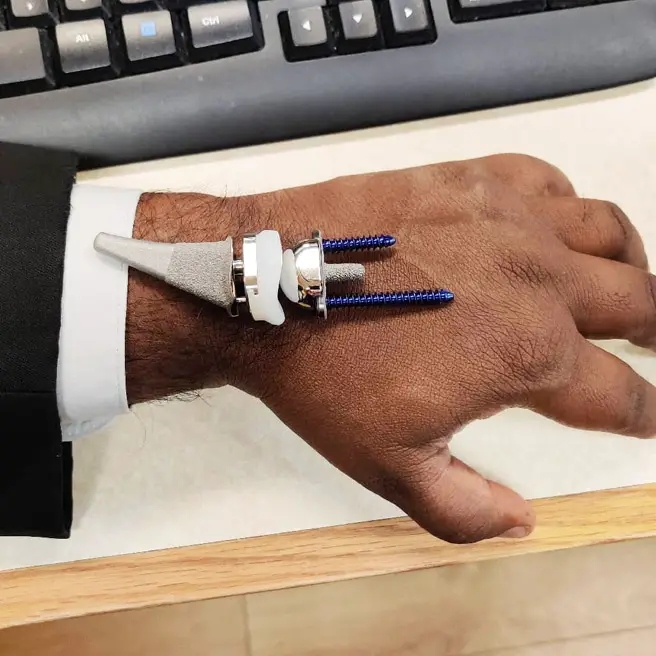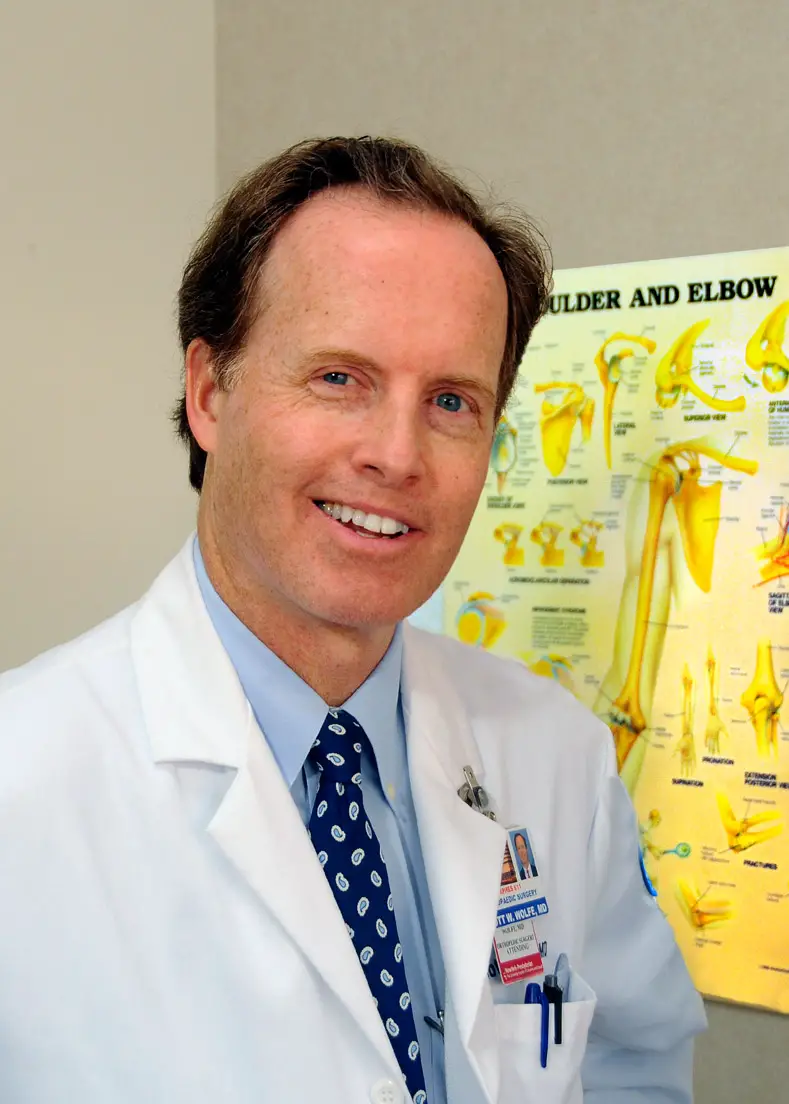It’s all in the wrist for Dr. Scott Wolfe.
Actually, that’s not completely true. The Greenwich resident is chief emeritus of the Hand and Upper Extremity Service at the Hospital for Special Surgery (HSS) in Manhattan, and therefore works on everything “from the shoulder down to the hand.”
But it is with the wrist that Wolfe and his longtime colleague Dr. Joseph (Trey) Crisco are making their current mark, inventing and patenting KinematX, an implant that goes well beyond standard wrist replacement surgery.

“Shoulder, knee and hip surgeries have become commonplace,” Wolfe told the Business Journal. “But what we were doing with the wrist was not as advanced because the wrist wasn’t as well understood.”
One of the main issues is wrist arthritis, which Wolfe said is one of the most common and debilitating conditions treated by hand surgeons, affecting about 5 million people in the U.S. alone.
Wrist joint replacement, or wrist arthroplasty, has traditionally involved scans showing two planes, he explained, to illustrate the up-and-down and side-to-side motions normally associated with most joints.
“But the wrist is more complex,” Wolfe said. “Our research proved that when you’re throwing a ball, hammering something, pouring something into a pitcher, you’re using movements in both of those planes. So there was a third, spherical plane that needed to be included.”
That research dates back more than 30 years, as Wolfe and Crisco — director of bioengineering at the Warren Alpert Medical School in Providence, and a professor of orthopedics and engineering at Brown University and Rhode Island Hospital — combined their talents to find a better way.

The first step, Wolfe said, was to pinpoint how the eight individual bones in a wrist work — not only in regular situations, but also where an injury has occurred.
“We needed to map what happens with all those little bones,” he said, “and identify the contours of each of them as they work through their different motions.”
The wrist movements are unique to humans, he said. “The most significant joint is our wrist — it’s likely more important than the opposable thumb in terms of evolution, because it allowed us to protect ourselves through tools and weapons, to throw and to hunt. Even the higher primates can’t do what we can in those terms.”
Having begun “in earnest” in 1990, the pair eventually hit upon the design and validation of a noninvasive three-dimensional motion analysis system to measure wrist kinematics — the wrist motions necessary for a range of activities — and began sketching out ideas for what would become KinematX.
As they began submitting their findings, Wolfe, Crisco and their team received over $10 million in research grants from the National Institutes of Health, which he said helped immensely as the years wore on.
Wolfe said the system was patented in 2009, “and then it took 10 years for us to get FDA approval.”
The KinematX Total Wrist Arthroplasty System, which is manufactured by Extremity Medical, received 510(k) clearance from the FDA at the end of March 2020 — just in time for the Covid-19 pandemic.
A patient patient
Although they may have been disappointed by the additional delay, Mark Eisen said he was not.
“I’d been following their research for years,” the 69-year-old Atlanta resident told the Business Journal. “In 2014, I’d realized something was going on with my right wrist, so I had it evaluated by different physicians. First it was diagnosed as mild arthritis, then it was ‘severe.’ They recommended traditional wrist surgery, which involves either taking bones out or screwing them all together. The idea was, ‘You won’t have the pain, but you won’t be able to move your wrist.’”
A quick study, Eisen noted that wrist surgery dates back to the 1890s. “They used ivory, then rubber, then they moved on to mechanical devices, which shows you how complicated the wrist is,” he said.
Although his arthritic condition continued to worsen — “And I’m right-handed,” he noted — Eisen was suitably encouraged by the progress he saw being made by Wolfe and Crisco to hang in there. Finally, on April 15, he became the first KinematX patient when Wolfe successfully implanted the device at HSS.
“He’s a very bright guy,” Wolfe said of Eisen. “He came in extremely well-informed, although we did have to explain some of the nuts and bolts to him.”
Eisen, who is eager to return to the golf course — “I haven’t played since 2014” — must remain patient. Scheduled to meet with the surgeon for a follow-up on June 14, he is still “not allowed to do anything forceful until the prosthesis grows into the bone,” Wolfe said. “It’s just like a tooth implant becoming one with the jawbone.”
The doctor said six weeks is the “absolute minimum” for normal activity to resume for most patients, with three to six months preferred. After all, he noted, research is still continuing, and the ultimate outcomes are not yet known.
But Wolfe is confident that the KinematX procedure, which takes about 90 minutes, will prove more durable than standard wrist replacement surgeries, which due primarily to the loosening of its implant components have failure rates of 50% within 5 to 10 years.
Four other surgical centers around the country are now cleared to conduct the procedure — Wolfe estimated at least five surgeries per center during its first year — with constant recording of data along the way.
“We’re not expecting hundreds and hundreds of these right away,” he said. “I’d love to do one a month at each facility.”
"traditional" - Google News
June 14, 2021 at 04:16PM
https://ift.tt/3xhPQPk
Greenwich doc invents implant that goes well beyond traditional wrist replacement - Westfair Online
"traditional" - Google News
https://ift.tt/36u1SIt
Shoes Man Tutorial
Pos News Update
Meme Update
Korean Entertainment News
Japan News Update
Bagikan Berita Ini















0 Response to "Greenwich doc invents implant that goes well beyond traditional wrist replacement - Westfair Online"
Post a Comment